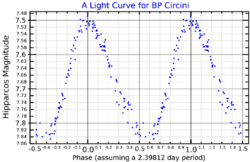Astronomy:BP Circini
From HandWiki
Short description: Star in the constellation Circinus
| Observation data Equinox J2000.0]] (ICRS) | |
|---|---|
| Constellation | Circinus |
| Right ascension | 14h 46m 41.98011s[2] |
| Declination | −61° 27′ 42.9903″[2] |
| Apparent magnitude (V) | 7.37 - 7.71[3] |
| Characteristics | |
| Spectral type | F2/3II + B6V[4] |
| B−V color index | 0.649±0.020[5] |
| Astrometry | |
| Proper motion (μ) | RA: −5.355[2] mas/yr Dec.: −3.920[2] mas/yr |
| Parallax (π) | 0.9952 ± 0.0402[2] mas |
| Distance | 3,300 ± 100 ly (1,000 ± 40 pc) |
| Absolute magnitude (MV) | −2.91[6] |
| Orbit[6] | |
| Period (P) | 20 yr |
| Semi-major axis (a) | 15.8 astronomical unit|AU |
| Details | |
| A | |
| Mass | 5[7] M☉ |
| Radius | 30.38+6.93 −6.50[2] R☉ |
| Luminosity | 917±54[2] L☉ |
| Surface gravity (log g) | 2.75[8] cgs |
| Temperature | 6356±23[8] K |
| B | |
| Mass | 4.7[6] M☉ |
| Surface gravity (log g) | 4.0±0.5[7] cgs |
| Temperature | 16,000±1,000[7] K |
| Other designations | |
| Database references | |
| SIMBAD | data |
BP Circini is a binary star system in the southern constellation of Circinus. It is located at a distance of approximately 3,300 light years from the Sun based on parallax.[2]
The variability of this star was discovered by D. W. Kurtz in 1979.[7] A small-amplitude Cepheid variable,[8] its apparent magnitude ranges from 7.37 to 7.71 over 2.39810 days.[3] A spectroscopic binary, the primary is a yellow-white bright giant of spectral type F2 or F3II.[4] The spectrum shows peculiarities in the metallic lines.[10] The secondary is a 4.7 solar mass (M☉) blue-white main sequence star of spectral type B6.[6]
References
- ↑ "Hipparcos Tools Interactive Data Access". ESA. https://www.cosmos.esa.int/web/hipparcos/interactive-data-access.
- ↑ 2.0 2.1 2.2 2.3 2.4 2.5 2.6 2.7 Brown, A. G. A. (August 2018). "Gaia Data Release 2: Summary of the contents and survey properties". Astronomy & Astrophysics 616: A1. doi:10.1051/0004-6361/201833051. Bibcode: 2018A&A...616A...1G. Gaia DR2 record for this source at VizieR.
- ↑ 3.0 3.1 BSJ (30 November 2013). "BP Circini". AAVSO Website. American Association of Variable Star Observers. http://www.aavso.org/vsx/index.php?view=detail.top&oid=9492. Retrieved 24 January 2014.
- ↑ 4.0 4.1 Skiff, B. A. (October 2014), "General Catalogue of Stellar Spectral Classifications", VizieR Online Data Catalog, Bibcode: 2014yCat....1.2023S
- ↑ Anderson, E.; Francis, Ch. (2012), "XHIP: An extended hipparcos compilation", Astronomy Letters 38 (5): 331, doi:10.1134/S1063773712050015, Bibcode: 2012AstL...38..331A.
- ↑ 6.0 6.1 6.2 6.3 Evans, Nancy Remage et al. (2013). "Binary Cepheids: Separations and Mass Ratios in 5M ⊙ Binaries". Astronomical Journal 146 (4): 93, 10 pp. doi:10.1088/0004-6256/146/4/93. Bibcode: 2013AJ....146...93E.
- ↑ 7.0 7.1 7.2 7.3 Petterson, O. K. L. et al. (May 2004). "The orbits of southern binary Cepheids". Monthly Notices of the Royal Astronomical Society 350 (1): 95–112. doi:10.1111/j.1365-2966.2004.07555.x. Bibcode: 2004MNRAS.350...95P.
- ↑ 8.0 8.1 8.2 Usenko, I. A. et al. (December 2014). "Spectroscopic studies of Cepheids in Circinus (AV Cir, BP Cir) and Triangulum Australe (R TrA, S TrA, U TrA, LR TrA)". Astronomy Letters 40 (12): 800–820. doi:10.1134/S1063773714110061. Bibcode: 2014AstL...40..800U.
- ↑ "V* BP Cir". SIMBAD. Centre de données astronomiques de Strasbourg. http://simbad.u-strasbg.fr/simbad/sim-basic?Ident=V%2A+BP+Cir.
- ↑ Kurtz, D. W. (1979). "HD 129708: A New, Bright, Short-Period Cepheid with an Unusual Spectrum". Monthly Notes of the Astronomical Society of Southern Africa 38: 36. Bibcode: 1979MNSSA..38...36K.
 |


